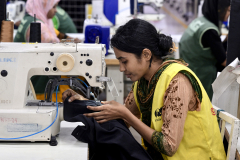Despite loud calls to make the fashion industry more sustainable—and ambitious commitments from brands—the sector’s climate impact just hit record highs, jumping over 7 percent from the year prior.
After several years of flat—and even declining—environmental impact for the fashion industry, this sudden spike is a true wake-up call. Fashion’s climate footprint already drives a significant portion of global warming, making up anywhere from 1.7 percent to 8 percent of the world’s emissions, depending on how the industry’s footprint is measured—whether that’s production alone or the full supply chain from raw materials to end of life. As the sector expands, so does its impact, driving consequences that extend far beyond its supply chain. These increasing emissions have knock-on effects for the climate, customers, and communities.

MUNIR UZ ZAMAN/AFP via Getty Images
Fashion’s surging environmental impact will exacerbate climate disruptions that are already reshaping every fabric of our lives, from the foods we eat to where we live to the air we breathe. The heightened risk of extreme storms, dangerous heat, wildfires, and other climate disasters makes production unpredictable and potentially more costly. A warming planet also means that sourcing materials like cotton and silk for clothes will be harder to find and more expensive.
The cost of inaction is enormous, measured not only in environmental damage but in the billions of dollars in lost productivity, disrupted supply chains, and rising resource costs that will hit the industry if we fail to act. Simply put, climate change means that business as usual is no longer an option for the fashion industry.
Many of the countries that are essential to the apparel industry—India, Bangladesh, Vietnam, Pakistan, Indonesia—are on the frontlines of climate change, experiencing heatwaves, flooding, and resource scarcity. In these regions, the cost of inaction is steepest, and continued emissions increases will be catastrophic to businesses, the environment, and people.
However, there are innovations in production and proven energy efficiency practices that offer hope, cutting the climate footprint of the apparel sector while reducing costs and improving worker well-being. Take heat pumps, for example, which transfer heat instead of generating it. This allows factories to offer an all-in-one solution: the heat needed for production and cooling for worker safety, without the emissions associated with fossil-fuel boilers.
Despite being more economically and environmentally efficient than fossil-fuel tech in the long-term, the upfront costs for these solutions may curr





